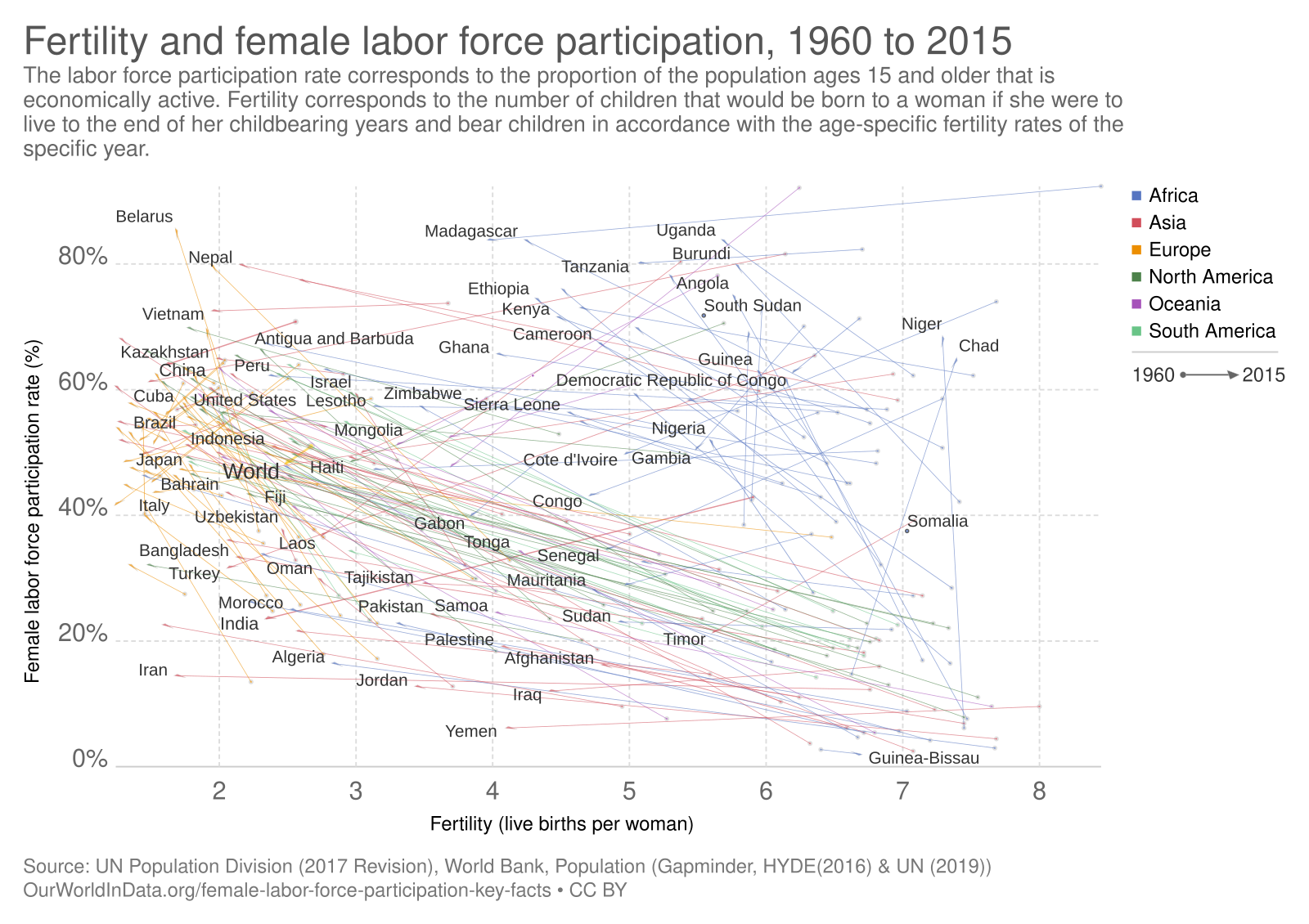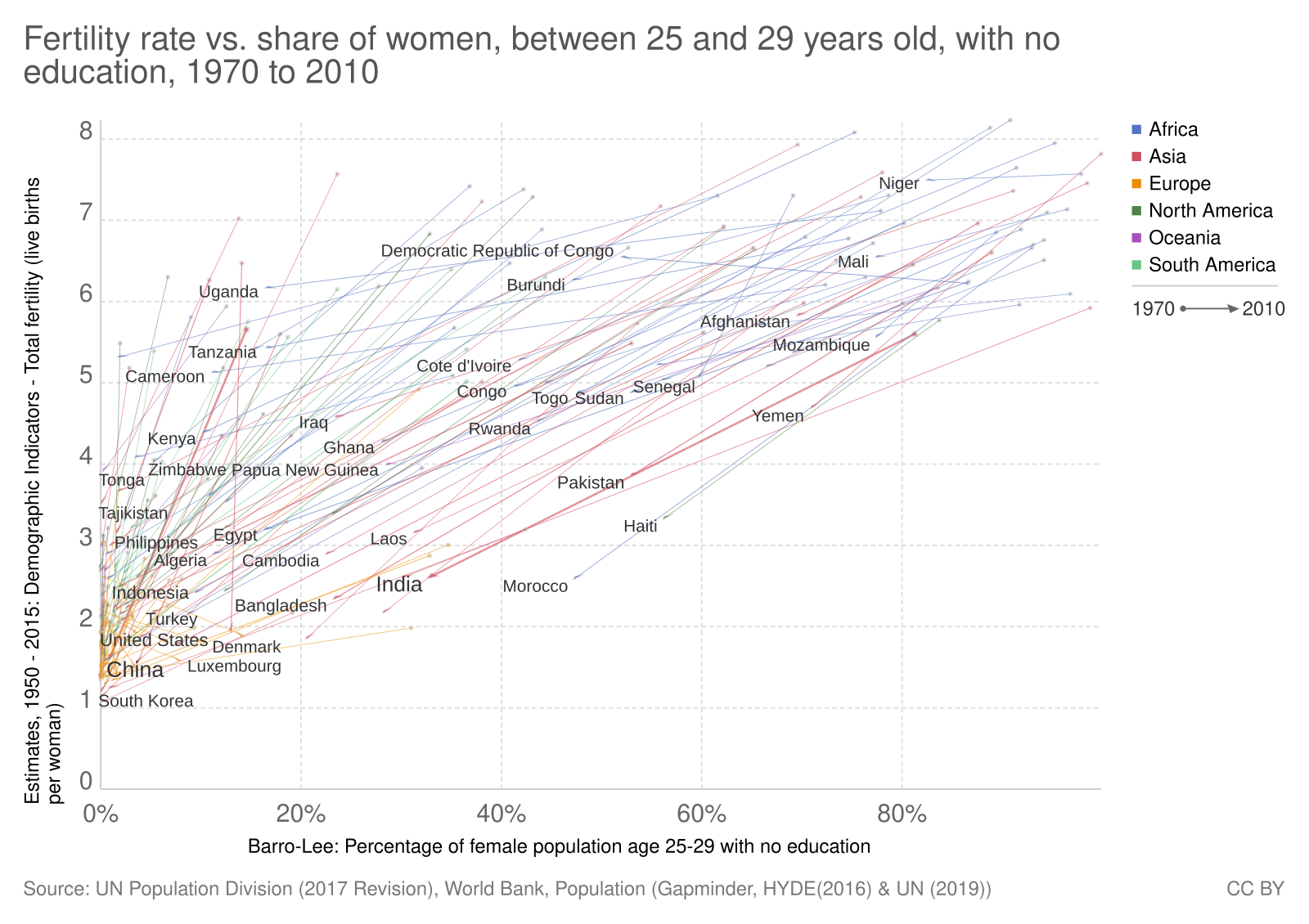IB Syllabus focus:
‘Policies improving gender equality, education, public health, and welfare indirectly affect births, deaths, and migration, thereby changing population growth.’
Indirect development policies shape population growth by addressing social, economic, and health conditions rather than directly controlling fertility or migration. These measures create lasting demographic changes.
Understanding Indirect Development Policies
Unlike direct population policies (such as one-child laws or pro-natalist incentives), indirect development policies modify the underlying determinants of fertility, mortality, and migration. By raising living standards and improving social opportunities, they alter how many children people have, how long they live, and where they move.
Key Areas of Indirect Development Policies
Gender Equality
Improving gender equality empowers women to make informed reproductive choices. When women gain equal rights and access to education and employment, fertility rates often decline.
Gender Equality: The state in which individuals of all genders have equal access to opportunities, rights, and resources in education, employment, and decision-making.
Policies may include:
Equal pay laws and workplace rights.
Access to family planning and reproductive health services.
Support for women in higher education and professional careers.
These policies reduce dependency on large families as women increasingly participate in the workforce.

Scatter plot comparing female labour force participation with total fertility rate across countries, showing that higher economic participation by women tends to coincide with fewer births. This relationship illustrates how equality-focused labour and welfare policies indirectly alter fertility behaviour. Source.
Education
Education is one of the strongest influences on population change.

Scatter plot of countries showing higher fertility where a larger share of women aged 25–29 have no education, and lower fertility where women’s schooling is more widespread. This visual reinforces how expanding girls’ and women’s education reduces average family size through informed reproductive choices. Source.
Total Fertility Rate (TFR): The average number of children a woman is expected to have during her reproductive years, assuming current age-specific fertility rates remain constant.
Key impacts of education include:
Improved literacy leading to awareness of family planning methods.
Greater employment opportunities reducing reliance on children for economic security.
Delayed age of marriage and childbearing.
Public Health Improvements
Rising life expectancy and declining mortality rates occur when health services, sanitation, and nutrition improve.

Interactive chart plotting under-five child mortality against DTP3 immunisation coverage by country, illustrating that higher vaccination coverage is associated with lower mortality. This visual exemplifies how investing in preventive healthcare shifts mortality downward—an indirect policy pathway that shapes population dynamics. Source.
Policies include:
Expanding vaccination and disease prevention.
Strengthening maternal and infant healthcare.
Ensuring clean water supply and improved sanitation infrastructure.
Welfare and Social Security Systems
Social welfare policies reduce the reliance on children for old-age support. When families can depend on pensions, unemployment benefits, or disability coverage, they often choose to have fewer children.
Examples include:
National pension schemes.
State-funded childcare and family allowances.
Subsidised housing and healthcare programmes.
Migration Effects
Indirect policies can also influence migration flows. For instance:
Improved employment opportunities reduce out-migration.
Better welfare and education systems attract immigration.
Reduced conflict and poverty lower forced displacement.
Population Growth and Demographic Change
Natural Increase and Mortality
Natural increase refers to population growth calculated as the difference between birth rates and death rates. Policies that reduce mortality without equivalent fertility changes can raise natural increase temporarily. Over time, however, fertility rates usually decline in response to these same improvements.
Doubling Time
Doubling Time (DT) = 70 ÷ Natural Increase Rate (%)
DT: Number of years required for a population to double in size.
Natural Increase Rate: Crude birth rate – crude death rate (as a percentage).
Indirect policies influence this equation by reducing crude birth rates and death rates simultaneously, resulting in a more stable population growth trajectory.
Link with the Demographic Transition Model
Indirect development policies push societies through the Demographic Transition Model (DTM) by encouraging movement from high birth and death rates to low birth and death rates.
In Stage 2, health improvements reduce mortality.
In Stage 3, education and gender equality reduce fertility.
In Stage 4, welfare systems support population stabilisation.
Examples of Indirect Development Policies in Action
Kerala, India
Kerala demonstrates how investment in female literacy, healthcare, and social security can reduce fertility without coercive policies. Despite limited income levels, its fertility rate fell to near replacement level due to long-standing emphasis on gender equality and education.
Sweden
Sweden’s welfare system, including universal healthcare and education, extensive childcare support, and gender equality laws, has stabilised fertility rates while maintaining a high standard of living.
Sub-Saharan Africa
In contrast, countries with limited healthcare, education, and welfare continue to experience high fertility and rapid growth. Development programmes targeting these areas represent ongoing indirect policy interventions.
Interconnections and Long-Term Implications
Indirect policies are more sustainable than direct controls because they:
Improve individual well-being while reducing pressure on populations.
Generate long-term demographic stability.
Promote resilience to economic, social, and environmental challenges.
By shaping fertility, mortality, and migration patterns through development, they indirectly but powerfully alter human population growth at local, national, and global scales.
FAQ
In low-income countries, indirect policies such as expanding female education or healthcare often have a stronger effect, as basic needs are unmet and improvements cause rapid demographic change.
In high-income countries, similar policies may stabilise already low fertility rates rather than significantly reduce them. The effectiveness depends on existing infrastructure, cultural values, and government capacity.
Gender equality enables women to delay childbearing, pursue education, and access careers. These changes directly reduce fertility rates and alter household decision-making patterns.
Access to reproductive healthcare
Economic independence
Participation in governance and policy-making
All contribute to long-term demographic stability.
In societies without welfare systems, children often act as a form of old-age security. Parents rely on them for economic and social support.
By contrast, pension schemes, unemployment benefits, and healthcare access reduce this dependency. Families no longer need large numbers of children for survival support, encouraging smaller family sizes.
Yes, they can. Strong welfare systems, educational opportunities, and public health services attract migrants, especially from less developed areas.
At the same time, when such policies reduce poverty and create jobs locally, they can slow emigration and reduce forced migration caused by poor living conditions.
The effects of indirect policies take decades to show visible impact, which can conflict with short-term political agendas.
Governments must also ensure sustainable funding for education, welfare, and healthcare. Cultural resistance, gender inequality, and uneven resource distribution can further limit their effectiveness in managing population growth.
Practice Questions
Question 1 (2 marks):
Identify two indirect development policies that can lead to a decline in fertility rates.
Mark scheme:
1 mark for each correct policy identified, up to 2 marks.
Examples:Improving female education (1)
Expanding access to public health services (1)
Strengthening welfare and pension systems (1)
Promoting gender equality in the workplace (1)
Question 2 (5 marks):
Explain how improvements in public health and education act as indirect development policies that influence population growth.
Mark scheme:
Clear explanation of the role of public health in reducing mortality rates (1).
Reference to increased life expectancy or decline in child mortality (1).
Explanation of how education, especially for women, reduces fertility rates (1).
Reference to delayed marriage or informed family planning choices due to education (1).
Linking both factors (health and education) to overall changes in population growth trends, such as slowing natural increase or movement through stages of the Demographic Transition Model (1).

